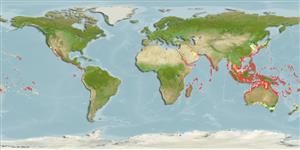Common names from other countries
Environment: milieu / climate zone / depth range / distribution range
Ecologie
; diepteverspreiding 0 - 50 m (Ref. 349). Tropical
Indo-Pacific.
Length at first maturity / Size / Gewicht / Leeftijd
Maturity: Lm ? range ? - ? cm Max length : 33.0 cm SHL mannelijk/geslacht niet bekend; (Ref. 349); common length : 20.0 cm SHL mannelijk/geslacht niet bekend; (Ref. 349)
This large and common species is actively collected in many parts of the Indo-West Pacific realm (Ref. 349). Maximum depth from Ref. 101003. Often on clean coarse sand and rubble bottoms in which large individuals partially bury themselves. Preys on bivalves and other gastropods (Ref. 349). Damages pearl oyster beds (Ref. 799).
Life cycle and mating behavior
Geslachtsrijpheid | Voortplanting | Kuitschieten | Eieren | Fecundity | Larven
This species is a non-broadcast spawner. Life cycle does not include trocophore stage. Also Ref. 833.
Poutiers, J.M. 1998. (Ref. 349)
Status op de Rode Lijst van het IUCN (Ref. 130435)
Status bij CITES (Ref. 108899)
Not Evaluated
Not Evaluated
Gevaarlijk voor mensen
Harmless
Gebruik door de mens
| FishSource |
Tools
Internet-bronnen
Estimates based on models
Preferred temperature
(Ref.
115969): 22.8 - 29.1, mean 28 (based on 1524 cells).
Kwetsbaarheid
Low vulnerability (23 of 100).
Prijsklasse
Unknown.
